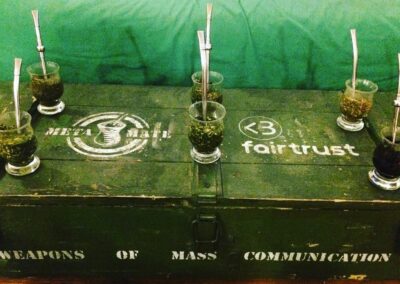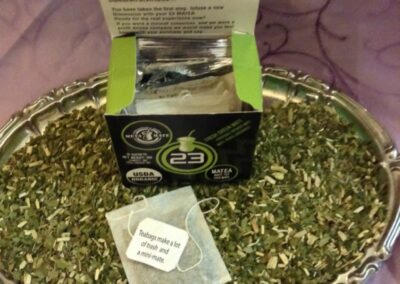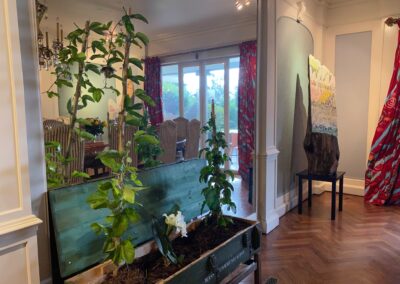According to the Gallerist Nina Menocal:
Weapons of Mass Communication
Reforestación y “decolonización” son el tema fundamental de la obra de Fabricio Do Canto, artista brasileiro invitado a Gallery Weekend – México. Es arte fuera del White Cube, donde se unen naturaleza y humanismo. Desde el fuego en la Amazonia a los nuevos verdores, la obra Weapons of Mass Communication es parte de un proyecto mayor que incluye performance, arte de denuncia e intervenciones políticas en el supermercado.
Lo que se conoce como Mate, infusión de yerba mate originaria de Paraná, Paraguay y Uruguay, se consume desde épocas prehispánicas por etnias tupí-guaraní y otras que comerciaban con ellos. Los españoles adoptaron el Mate a la cultura de Argentina, tambien a la de los demás países de Sudamérica. De aquí fue llevado a Siria y Líbano por argentinos que retornaban a esos países. Como el té, café o chocolate tiene cafeína y es estimulante. Se bebe caliente con la “bombilla” que está dentro de la infusión.
Los indígenas tomaban Mate como medio de comunicación más profunda, su ritual y substancia fue colonizada con el tiempo y actualmente se le llama Quechua al tazón, Caá al bosque. En Alemania el Mate es fuerza de cambio a través de los hackers de las redes, productores y consumidores. Sí, sucede que los jóvenes principalmente y personas de 40 años para abajo en Berlín toman Mate en lugar de café, Mate embotellado como cola, fuente de energía y salud. Esta bebida que ha sido la selección alemana y se está expandiendo a los Estados Unidos, pronto llegará a México. El Mate es presagio de una especie de brujería. El que lo prueba, sabor adquirido, llega a convertirse en adicto.
Fabricio do Canto: a man, an artist
Fabricio do Canto (Alegrete, Brazil, 1969) has entered the contemporary art scene as an artist of a new type, a kind of “Brazilian Beuys”, as Javier Sicilia has baptized him. His artistic practice escapes from the more traditional pigeonholes and his works work organically inside and outside the gallery space. His extensive training in the world of marketing and business administration – graduated in 1992 from the University of Santa Maria in Brazil and International Product Manager at Beiresdorf Ag in Germany – have allowed him to use this experience to create “artistic products”. –with a practical result and social impact–, where the markentig becomes the medium, just as painting or sculpture could be. Exactly as Joseph Beuys aspired to create new models that lead society towards other paths, under the premise of “every man is an artist”; Fabricio develops a group of works that challenge the logic of the world of art and business; gives new values to the relationship between the buyer/collector and the seller/gallery owner. Although he has developed an interesting work within performance –taking the activist duo Yes Men as a reference–, almost all of his work operates by dismantling the usual ways of understanding the artistic fact; unlike Andy Wharhol, he has brought the world of art to the supermarket. Do Canto, in his double capacity as artist and businessman, subjects the viewer to an unusual reflection on the processes of art consumption and the market.
One of the first works that he materialized, in collaboration with Krithika do Canto, was Rainbow Children. It consists of a field investigation on the meaning of colors that reveals how healthy children can learn from so-called children with “special abilities”. More than 70 key chains were made, in addition to films and photos, where each one had the website that showed the need and the therapy proposed to the children. More than 70 children in India got their therapy paid for by the project. Based on this same idea of educational collaboration, he carried out, together with Michael Saup, Krithika do Canto and Jorge Bodansky, the Nomad University: an itinerant cultural center that brought art and painting and drawing classes to the most remote populations on the banks of the river. Amazon.
In Berlin, he also made an important artistic intervention in which he printed an article simulating the German newspaper Kunst on newsprint and placed this “fake” page in the art magazine of the same name, which is distributed free of charge in cafes and restaurants in Berlin. . The print portrayed an intervention in the “Topography of Terror” exhibition and other themes that connected relevant political and social issues at the time.
For Fabricio, the new challenge facing humanity and probably its most immediate challenge, that of the fight against climate change, acquires a very personal nuance as Brazil is his birthplace. The Amazon is going through this new silent “war” without soldiers with an imminent result on the indigenous populations of the region. The protection of forests has become a point of paramount importance in his career, where he combines his facet as an artist and businessman with that of an activist for environmental care. Meta Mate –which works both as a drink and as an artistic project in itself– as its name indicates through the word Meta, going beyond mate, aims to confront the deforestation that large monoculture systems have produced from the consumption of mate, the elaboration process of which does not require the destruction of enormous green areas and which, in addition, actively involves the indigenous populations of the region. The packaging of this mate, likewise, has been designed by numerous artists, in such a way that they transform the world of the supermarket into a kind of “high consumption” gallery.
The apparent peaceful nature of these collages is reversed by the artist using two subtle elements: a kind of red drops that recall the indigenous blood that is lost daily in that territory, as well as the decollage of the yonamami figure, leaving just a trace on the invoices that serve as support. This fading of faces over these old business vouchers tries to highlight the cancellation that, little by little, this culture and the lifestyle of its inhabitants are suffering, as well as the long history of this conflict. Ultimately, Where are the Yanomami not only involves a sharp reflection on the violence to which this indigenous population is subjected, but almost all the original peoples of South America, as well as the progressive cultural standardization due to the excessive development of capitalism and its relentless advance.
Laura Arañó Arencibia, August 2022
Curator of (Museo Nacional de Bellas Artes – Havana, Cuba)










